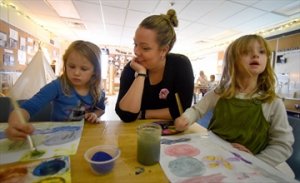
Fostering calm in the classroom
Hamilton Spectator
By Emma Reilly

Photo: Barry Gray,The Hamilton Spectator
Teacher Christa Bailey in her kindergarten class with students Kylie, left, and Abby. The colours are muted, the lighting softer.
In Christa Bailey’s kindergarten class, three- and four-year-old students stream in from recess to a classroom lit with floor lamps and a string of glowing Christmas lights. An essential oil diffuser sends a warm scent of cinnamon and spice into the air. A recording of Pachelbel’s “Canon in D major” plays in the background.
It’s a far cry from the rows of desks and bright overhead lights that adorn a traditional classroom.
“We want it to look beautiful for them,” Bailey said. “We want it to be appealing and thought-provoking when they use the space.”
Along with early childhood educator Lisa Corsini, Bailey created this calming environment as part of a schoolwide overhaul at Millgrove School. Millgrove teachers have ditched the primary colours and bright lights in favour of soothing, flexible, and more welcoming spaces.
Millgrove staff say it makes their students calmer, more focused, and happier to be at school.
“I’ve noticed a huge difference in their behaviour last year to this year,” said principal Danny Fede.
The makeover, which took place over the summer, was Fede’s brainchild. He encouraged teachers to add natural elements to their classrooms, replace bright plastic storage bins with wood and wicker, and remove loud posters from their corkboards and walls.
“The whole philosophy comes from making a bridge between home and school — take away the institutionalization of a building,” he said.
“When kids come to school and they see “school,” it’s a whole different mindset. If they come to school and it’s a reflection of their home, they’re much more comfortable. The busyness is gone, so they’re focused. They’re much more engaged, and once they’re more engaged, they’re more excited to come to school.”
Fede, who also follows the same philosophy in his office, say that even the parents that come into his office tend to relax.
“It’s calming for everybody,” he said.
Richard Messina, the principal of the Dr. Eric Jackman Institute of Child Study Laboratory School at the Ontario Institute for Studies in Education, says environment has a huge impact on the way students learn.
“There’s actually a significant amount of research that says everything from the amount of daylight that comes into the windows, to the workspace and flexibility, has incredible impact on children,” he said.
“If children feel psychologically secure — and if the environment helps them to feel secure — the research tends to show that they’re more able to build their potential. They feel safe, so they take more risks.”
Messina also points out that architecturally speaking, schools have traditionally had more in common with prisons than with any other type of building. Both of those institutions tend to feature cinder blocks, concrete, and florescent lighting — “everything that we know is not conducive to a warm atmosphere,” he said.
Across the hall from Bailey’s kindergarten class, Jennifer Kershaw’s Grade 2 classroom features many of the same soothing, natural elements. However, in Kershaw’s class, there are no assigned seats. Students store their work in cubbies near the door and choose from several different workstations — a standing desk, a low coffee table, a group of chairs around a table, or pillows on the floor.
The idea is to let students learn where they feel comfortable, Kershaw says, and empower them to take control over their own learning.
“You can pick which one you can concentrate more at,” said seven-year-old Justus Guerette, one of Kershaw’s students.
“Instead of being told what they have to do, they’re learning to make choices about what’s best for them,” said Kershaw. “Allowing them to sit in the place that’s best for them has allowed them to focus.”
Updated on Monday, November 28, 2016.

